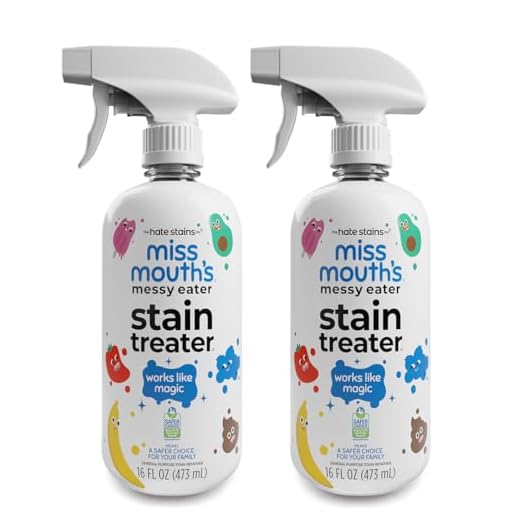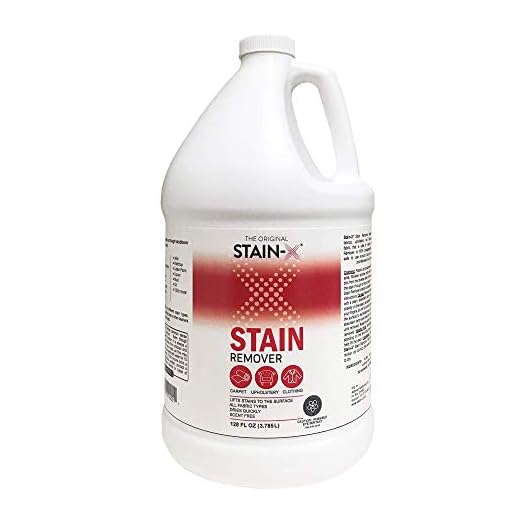



Act quickly to tackle those troublesome marks: sprinkle salt generously on the area to absorb excess liquid. This simple step can prevent deeper penetration into the fibers. Allow it to sit for a few minutes before proceeding.
Next, mix a solution of cold water and a few drops of dish soap. Gently dab the affected area with a clean cloth soaked in this mixture. Avoid rubbing, as this could spread the liquid further. Blot carefully, and then rinse with cold water to remove any soap residue.
If the mark persists, consider using white vinegar and water in a 1:1 ratio. Apply this blend to the area, allowing it to sit for approximately 30 minutes. This should help lift the remaining discoloration. Follow up with another rinse to ensure all residues are gone.
For more stubborn cases, a stain remover specifically designed for tough marks can be your ally. Apply according to the product instructions, and make sure to test it on an inconspicuous area first to avoid any unwanted damage to the fabric.
Finally, launder your garment as per the care label instructions, but refrain from drying it until you’re certain the blemish is fully eradicated. Heat can set the problem, making it much harder to rectify.
Effective Techniques for Treating Red Wine Accidents on Colorful Fabrics
Act quickly by blotting the affected area with a clean cloth or paper towel. Press gently to absorb excess liquid without rubbing, which may spread the issue. Avoid hot water, as it can set the discoloration into the fabric.
Immediate Solutions
Apply a generous amount of salt to the area. The granules absorb the liquid. After a few minutes, rinse with cold water. Alternatively, mix white vinegar and dish soap in equal parts, apply to the area, and let it sit for about 30 minutes before rinsing.
Long-Term Care
If the issue persists, consider using a commercial stain remover specifically designed for delicate fabrics. Follow the manufacturer’s instructions and test on an inconspicuous area first. After treatment, launder the item according to the care label, using cold water and a gentle cycle.
| Material | Recommended Treatment |
|---|---|
| Cotton | Vinegar and soap solution |
| Synthetic | Commercial stain remover |
| Silk | Blot with cold water and seek professional cleaning |
Act Quickly: The Importance of Immediate Action
Addressing a mishap without delay is paramount. The longer a liquid penetrates the fibers, the more challenging it becomes to eliminate the mark. As soon as the incident occurs, blot the area gently using a clean cloth or paper towel to absorb as much of the liquid as possible. Avoid rubbing, as this can spread the liquid further into the fabric.
Applying a cold water rinse immediately can help dilute the impact. This initial response can significantly reduce the chances of a permanent mark. If available, utilizing a specialized treatment or a mixture of mild detergent and cold water can enhance the removal process. Always test any solution on a hidden area first to ensure it will not cause discoloration.
Taking swift action not only aids in lifting the blemish but also preserves the integrity of the garment. Time is of the essence, and each moment counts in preventing lasting damage. Act decisively, and you can save your favorite pieces from unwanted marks.
Choosing the Right Stain Remover for Colored Fabrics
Opt for a product designed specifically for vibrant materials to ensure safety and effectiveness. Look for enzymatic cleaners that tackle organic compounds without compromising colors. Test any solution on an inconspicuous area first to check for colorfastness.
Ingredients to Seek
Identify removers with ingredients like sodium bicarbonate or hydrogen peroxide. These naturally derived substances are gentle yet powerful against unwanted marks. Avoid bleach-based products, as they can lead to discoloration or damage to the fabric.
Application Techniques
Apply the chosen solution directly to the affected area, gently dabbing with a clean cloth. Avoid rubbing, as it may cause further spreading. Let the cleaner sit for the recommended time before rinsing thoroughly. Always follow the manufacturer’s instructions for the best results.
In my experience, the right approach combined with proper materials can make a significant difference in maintaining the integrity of your garments.
Step-by-Step Guide: Blotting and Treating the Stain
Immediately blot the affected area with a clean, dry cloth or paper towel to absorb as much liquid as possible. Avoid rubbing, as this can spread the pigment further into the fibers.
Once you’ve soaked up the excess, sprinkle baking soda or salt onto the stain. These substances can help absorb residual moisture and color. Let it sit for a few minutes before gently brushing it off.
Next, prepare a mixture of cool water and a few drops of dish soap or laundry detergent. Dampen a cloth in this solution and dab the area, starting from the outside of the stain and working inward. This technique minimizes spreading and effectively breaks down the pigment.
After treating the area, rinse the fabric under cool running water. Ensure that the water flows through the back of the fabric to push the color out rather than through the front, which might force it deeper.
If the discoloration persists, apply a stain remover specifically designed for delicate materials. Follow the product instructions carefully. Allow it to set for the recommended time before rinsing again.
Finally, launder the item as per the care label instructions. Check the garment before putting it in the dryer; heat can set any remaining marks. If the stain remains, repeat the process or consider consulting expert advice.
Testing for Colorfastness Before Applying Solutions
Before attempting any treatment, assess the fabric’s ability to retain its hue. This ensures that the chosen method will not cause further damage. Follow these steps for a reliable evaluation:
- Identify the Fabric: Check the care label for material information. Synthetic fibers may react differently than natural ones.
- Prepare a Test Area: Choose a small, inconspicuous part of the garment, like an inner seam or hem.
- Moisten a Cotton Swab: Use water or a diluted cleaning solution on a cotton swab.
- Apply to Test Area: Gently dab the swab on the selected spot. Observe for any color transfer onto the swab.
- Assess the Reaction: If color comes off, the fabric may not withstand aggressive treatments. Consider milder options.
Always prioritize the integrity of the fabric. When in doubt, consult a professional cleaner for guidance tailored to specific materials.
Home Remedies: Natural Solutions for Stain Removal
Utilize white vinegar as an effective treatment. Mix one part vinegar with two parts water and apply it to the affected area. Allow it to sit for 30 minutes before rinsing with cold water.
Baking soda can also be beneficial. Create a paste by combining baking soda with a small amount of water. Apply this mixture to the mark and let it dry completely before brushing it off or rinsing.
Lemon Juice and Salt
For a refreshing approach, sprinkle salt over the affected area and then drizzle lemon juice on top. The combination of acidity and abrasiveness works well. Leave it for about 30 minutes before washing the item as usual.
Club Soda Magic
Use club soda as a pre-treatment by pouring it directly onto the mark. The carbonation helps lift the discoloration. Blot with a clean cloth, then rinse with cold water.
- Always test on a hidden area first to ensure color safety.
- Repeat the application if necessary, as natural solutions can be slower to act.
- Follow with a gentle wash cycle to fully eliminate any residue.
Consider using corn starch for a dry method. Sprinkle it on the mark and let it absorb for several hours. Brush off the powder and launder the fabric afterward.
These natural remedies can effectively tackle unexpected accidents, keeping your garments looking fresh and vibrant.
When to Seek Professional Cleaning Assistance
For those persistent marks that resist home treatments, consulting a cleaning expert is advisable. If the fabric is delicate, like silk or wool, or if the item is particularly valuable, it’s best to avoid DIY methods that might cause more harm than good.
Consider professional help if:
1. The Mark is Old
Stains that have set over time require specialized techniques and products that may not be available at home. Waiting too long can complicate the removal process significantly.
2. The Fabric is Sensitive
Items labeled as dry clean only or those with embellishments should not be treated with harsh chemicals. A professional service will know the appropriate methods to handle such materials without causing damage.
Additionally, if you find that home remedies are only partially effective, a cleaning service can provide targeted solutions tailored to the specific fabric type and stain condition. Their expertise often results in better outcomes, preserving the integrity of your garments and ensuring they look their best.
In summary, when in doubt about the right approach, seeking expert assistance can save time, money, and the risk of damaging your clothing.







